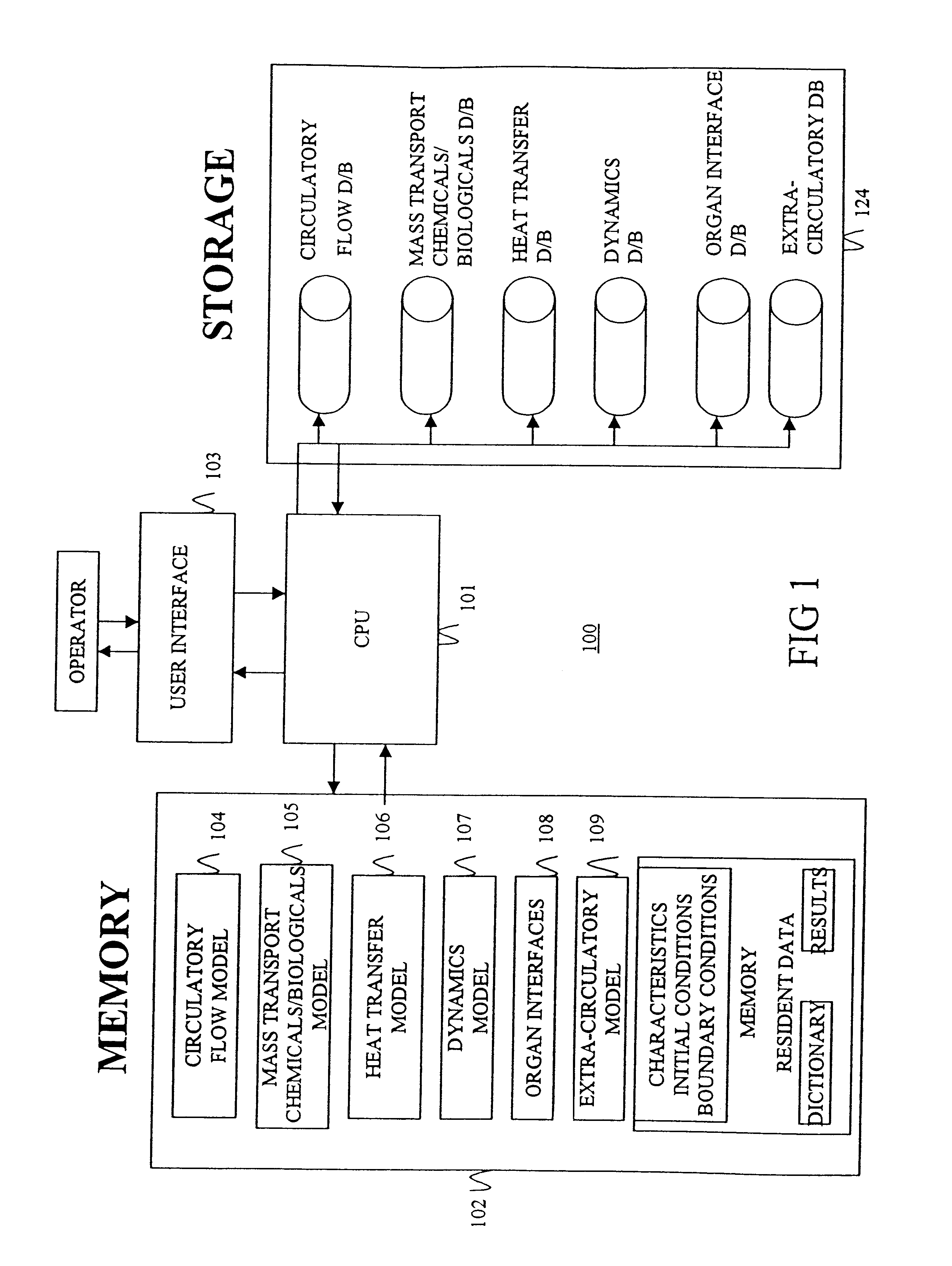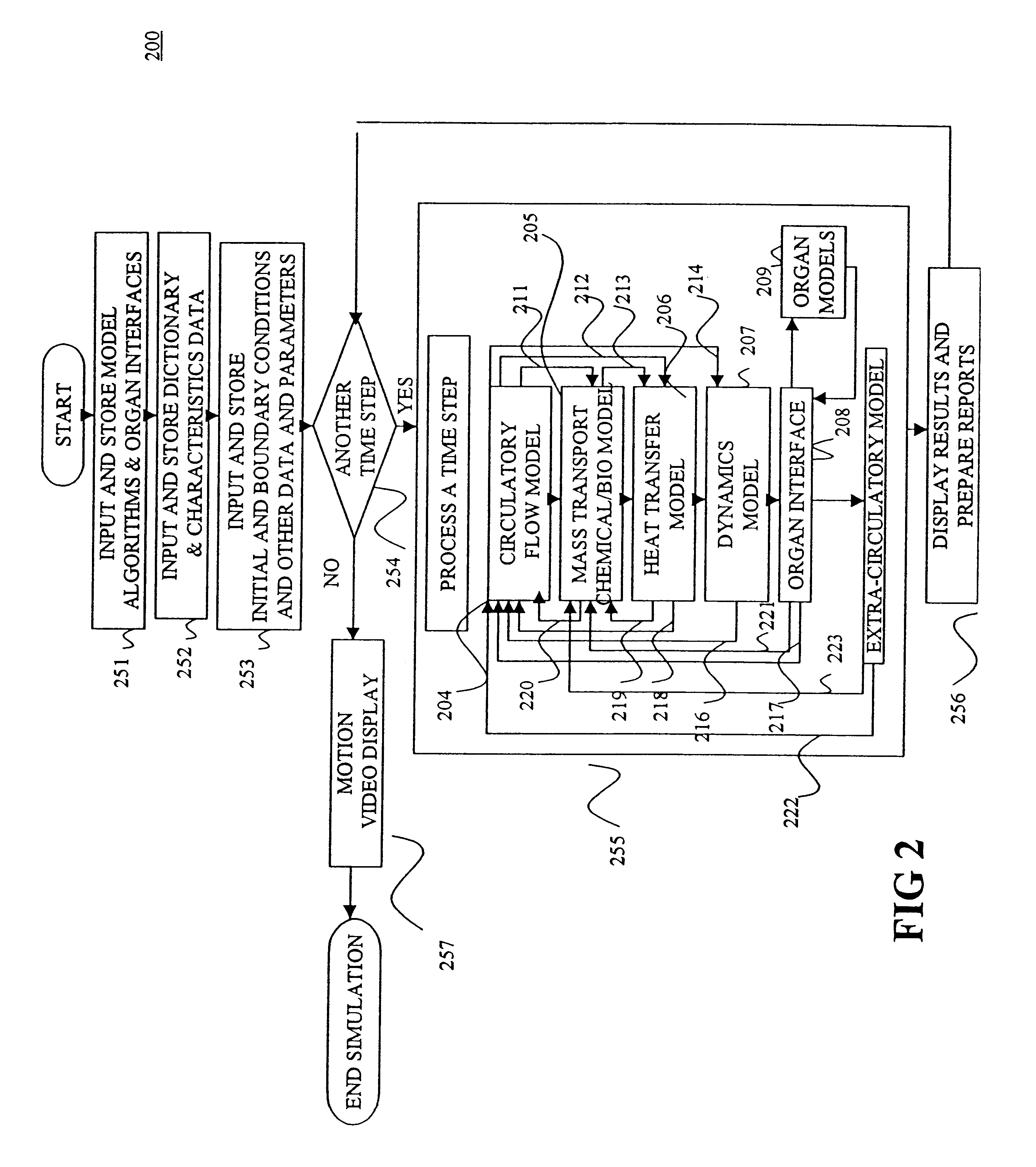The present invention provides an approach for analyzing bio-transport dynamics that overcomes the above-identified problems by simulating,
in silico, a bio-transport system of an organism using a configurable simulation model. The configurable simulation model provides a generic framework that is readily customizable to simulate one or more bio-transport dynamics aspects of a user-defined bio-transport system as a function of both time and position within the system. More specifically, the present invention applies finite-element techniques along with first principles and empirical relationships to a bio-transport system to construct mathematical representations of one or more bio-transport dynamics in and around the bio-transport system based on user-characterized elements representing the bio-transport system. By using a finite-element approach, the bio-transport system can be compartmentalized to manage its intricacies and provide sophisticated bio-transport
dynamic data not only as a function of time, but also as a function of the spatial position locating each element defined.
In a preferred embodiment, the simulation model has an
open architecture to permit concurrent,
interoperability with complementary models. Such a feature is particularly useful in enabling organ simulators to be networked to provide for more realistic simulations. Since organs are connected by the circulatory system, to model the behavior of an organ in situ, an organ simulator also should be able to simulate the circulatory system through which it communicates chemically and biologically with the rest of the organism and with certain extra-circulatory functional interactions, such as the
central nervous system. In addition to providing a common platform to network organs, the simulation model of the present invention provides an open interface for
interconnection among various organ models. This saves developers of organ simulators the effort of individually constructing an ancillary circulatory simulator with extra-circulatory functional interactions for each
organ model. Additionally, groups of organ developers can leverage on one another's modeling efforts by jointly using the interface provided by the present invention over remote connections, such as
the Internet. Thus, the simulation model of the present invention constitutes a global platform for collaborative research on physiological processes of organisms.
In addition to configuring the simulation model of the present invention as an inter-organ transport model, it may configured as an intra-organ, intra-tissue or intra-
cell transport model. In other words, the configurability of the simulation model of the present invention also enables it to simulate fluid flow and transport within an organ, tissue or
cell. With respect to organs, flow and transport phenomena underlie the basic behavior of many organs. At least one organ has already been modeled in a fashion to approximate a time-space continuum, for example, in Winslow, R. et.al "Simulating Cardiac Sinus and Atrial Network Dynamics on the Connection
Machine" Physica D 64 pp281-298, 1993. Likewise, with respect to cells, Tomita, M. et.al. "E-
CELL:
Software Environment for
Whole Cell Simulation" Bio. Mag. Keio 1996 describes an "E-
CELL simulator" that emulates transcription, translation and other chemical reactions occurring in the
cell.
Cell modeling, as described in that paper, would be enhanced by the inclusion of fluid flow, chemical / biological and
thermal transport phenomena and possibly dynamic effects. Instead of repeating the effort of creating a bio-transport simulator bound to a specific organ, tissue or
cell model for each organ, tissue and cell respectively, the simulation model of the present invention, with its ability to be configured and its
open architecture, can be used as the bio-transport simulator component in any organ, tissue or
cell model, thereby relieving the model developer of the task of managing the bio-transport part of the organ, tissue or cell simulation. Thus, the bio-transport simulation model becomes a simple "bio-transport object" in a modem object-oriented
programming environment, or its equivalent in a more-traditional
programming environment. It is anticipated that the use of this bio-transport object will accelerate the development of new physiological models and leverage many existing
ordinary differential equation [ODE] models of physiological processes by reducing the effort to incorporate true spatial representations using partial differential equations [PDE] into the models.
Another aspect of the invention involves an apparatus for simulating a bio-transport system. In a preferred embodiment, the apparatus comprises (a) a processor; (b) a
user interface operatively connected to the processor for receiving input from and conveying output to a user; and (c) memory operatively connected to the processor and containing instructions for constructing and / or executing the simulation model as described above. Preferably, the
user interface prompts the user in a logical fashion to define and characterize the elements to represent the transport system to the desired precision / accuracy. Additionally, the
user interface preferably displays output in a natural fashion so that the user can intuitively interpret results, thereby reducing errors and increasing acceptability. To this end, it is preferable to employ a structural arrangement of computational code that harmonizes with the natural display of results.
 Login to View More
Login to View More  Login to View More
Login to View More 


